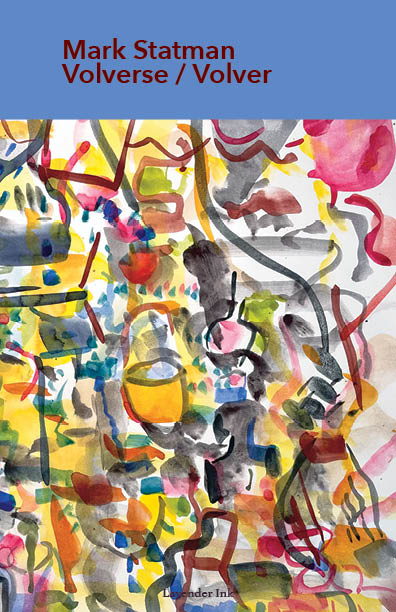
Part 2 MARK STATMAN: MEXICO AND THE POETRY OF GRIEF AND CELEBRATION
Part 2 of my interview with Mark Statman looks closely at Mark’s Latin American poetic influences, his life in Mexico and ends with an extract
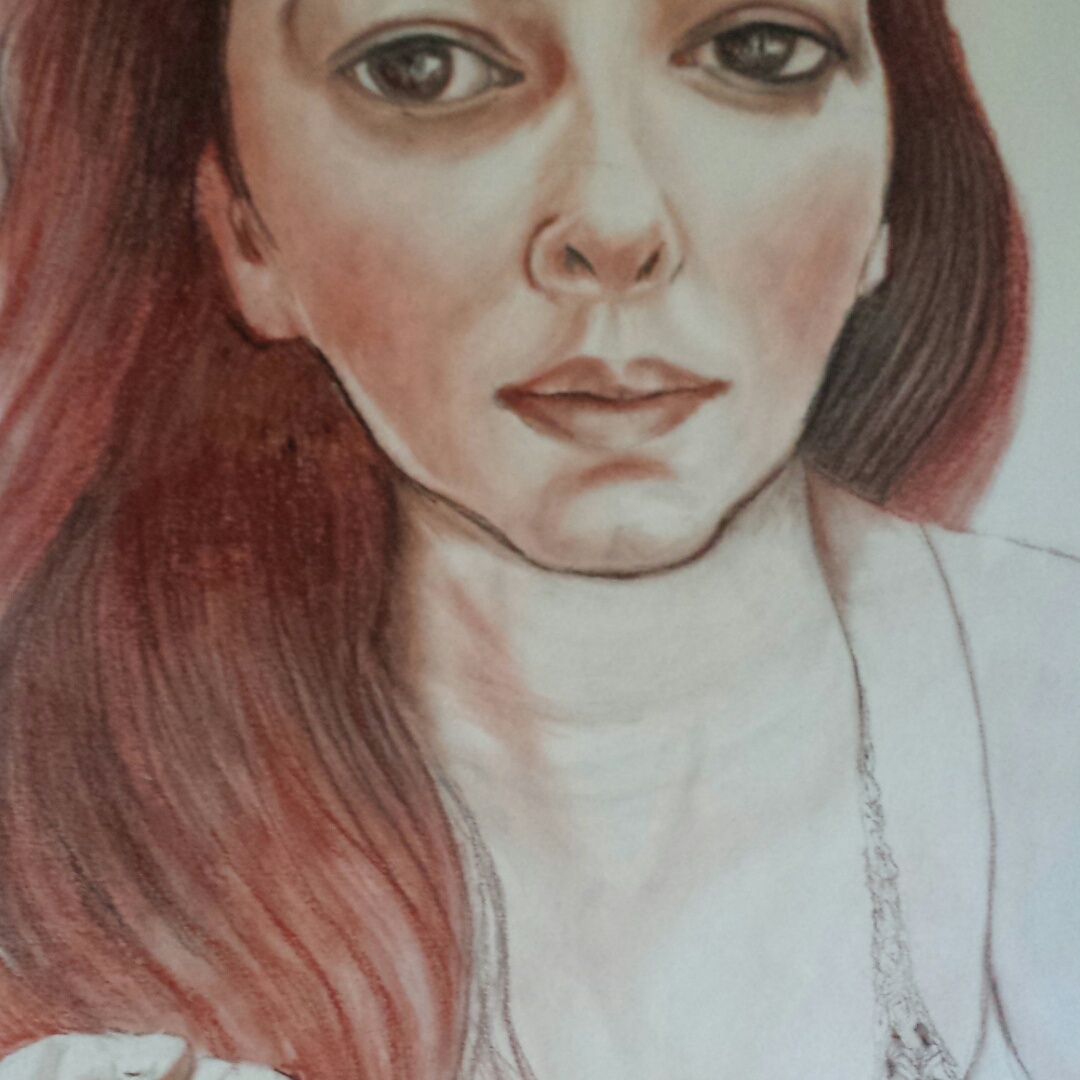

I first met painter and sculptor Sheelagh Frew Crane at the LP Café in Watford where she was playing a ‘voices-off’ part in a modernist play. When we talked later I realised that the idea of people hearing invisible voices was central to Sheelagh’s own artistic concerns.
When I asked her about the first signs of hearing voices in life, she described an incident that happened to someone she knew who had been leaving a room when a voice spoke, “Don’t go through that door.” The big shock for that person, Sheelagh said, was the real and absolutely external nature of the voice with no one else in the room. What usually followed, Sheelagh said, was a struggle against a rising tide of voices, often becoming menacing, then a ‘diagnosis’ followed by a long period of heavy medication, until finally the person came to accept the voices as a dialogue, establishing a working relationship.
Leslie: How did this subject for your art begin?
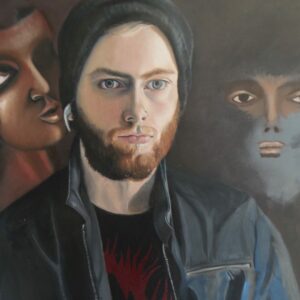
Sheelagh: Hearing voices is a journey I’ve been on for a long time which goes deep. When someone close to you goes through a door where you cannot follow and the only thing you can do is look through a window at them while they’re experiencing the nightmares of a strange new world, you have to do what it takes to learn about it – communicate and understand so you can help them. It’s a long journey for everybody involved and it has inspired much of my art – which is precious to me, not because it’s good, but because I need it. It’s a way helping others to see what an invisible illness is like. Not how the media paints it, but a true representation of what I have seen. These people have been so misrepresented in the past, and it is good to view them with fresh eyes.
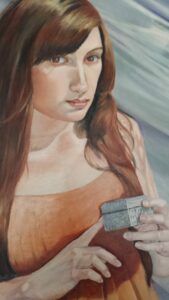
So a body of work came about called ‘Behind The Veil’, a set of oil paintings worked in a Renaissance way using glazing and layers as metaphors for the misconceptions and hidden truths about those different life experiences. I’ve always been interested in symbolism and liked the idea of incorporating it into the art so there is something in every painting to get you thinking. Because of my passion for the project, it certainly has pushed me beyond where I thought it would stop.
Leslie: Tell me about the journey your art has been through and what you’ve learned on the way.
Sheelagh: Over the years my art has developed from the early days of illustrations and designing clothes to having my first solo mixed-art exhibition, which begins on November 5th and runs to December 19th at the Space2 Gallery, Watford Museum. It’s been hard work, but there have been comic situations on the way such as when I’m wrapping Mark, my husband, up in tape for a sculpture and the doorbell rings. What I have learned is that people either get it or they don’t. Now I think it doesn’t really matter if they don’t like my work because I couldn’t imagine my life now without art, it’s who I am.
Leslie: When you’re creating an artwork, how do your ideas begin, grow and develop?
Sheelagh: I find ideas in all sorts of things and situations. Sometimes I wake up with a tiny thought, write it down and then toy with it for days, weeks or even months. Some of the ideas I’ve had for my exhibition have been with me since 2014, and they’ve slowly grown and changed. As my work grows, so do my emotions and feeling for the piece I am painting. I try to go to a place in my head via music, thinking about certain influences, and it’s often there where the real ideas develop and understanding takes place. It’s like a pool of creative understanding and it mostly comes when I am alone with my art.
Leslie: What artistic techniques and personal routines do you use when you’re creating an artwork?
Sheelagh: My pieces are mostly worked out initially before I start the project but while I am painting I often come up with something new to integrate into the art. The art itself is built up from studies firstly in pencil, sanguine and pastel. When it goes to canvas, I start with grisaille, and build up in colours from there.
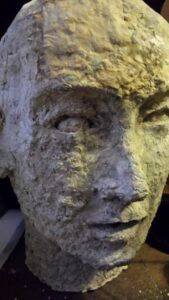
I tend to work on projects in rotation. I would find it hard to just stick to one piece at a time. I have an appetite for many art forms which wouldn’t happen without rotation. Like today, I painted all day, probably 7 hours, but yesterday I was making and casting moulds for my sculpture, and the day before I was filming. It can be exhausting so I have to remember to have some time doing something just for pleasure, like reading or watching a film.
Leslie: Which artists have influenced you?
Sheelagh: As I am quite eclectic my influences are wide, but here are my top eight:
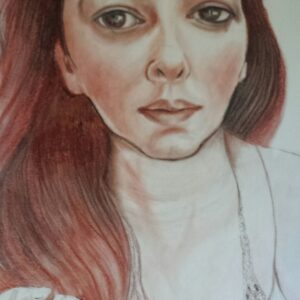
keeps the onlooker’s eye continually interested. She uses a limited palette for most of her art, a technique I’ve used in my exhibition.
| THE HEARING VOICES ORGANISATION has this to say about the subject:
‘Sound research with many voice hearers, both within and outside of mental health services, has found that how voice hearers cope with their voices depends not on the content of the voice experience (which can be either abusive and devaluing or guiding and inspiring – or both) but on the nature of the relationship with the voices. If you believe the voices to be in control you can’t cope; if you believe you are stronger than the voices are, you can. This means it is no longer a sustainable position to think of voices as part of a disease syndrome, such as schizophrenia. Instead hearing voices can be regarded as a meaningful, real (although sometimes painful, fearful and overwhelming) experience that speaks to the person in a metaphorical way about their life, emotions and environment. For instance, people experiencing distress as a consequence of abusive or commanding voices can often recognise their voices as those of their actual abusers and the voices have the effect of attacking their sense of self-esteem and worth. Having discovered these kinds of relationships, psychiatrists and psychologists in the UK and the Netherlands are developing techniques to help voice hearers focus on their experience and get to know their voices better. The new approach helps the voice hearer to make space for the voices, to listen but not to necessarily obey, to engage, but in their own time and space – essentially to learn how to control them within their own explanatory framework. This acceptance of the voices is crucial to growth and resolution. Voice hearers who have learnt these techniques can now say, “I hear voices, they are part of me and I am glad they are.”’ In an exceptional Ted Talk, Eleanor Longden describes her struggle with hearing voices. You can view her talk here. |
A NUMBER OF WELL-KNOWN PEOPLE have experienced hearing voices:
Anthony Hopkins “I’ve always had a little voice in my head, particularly when I was younger and less assured”, he said. “While onstage, during classical theatre the voice would suddenly say, Oh, you think you can do Shakespeare, do you?” and he added: “Recently, I was being interviewed on television and the voice inside my head said to me, Who the hell do you think you are. You’re just an actor, what the hell do you know about anything?” Zoe Wannamaker “It’s like a little person sitting on your shoulder saying No that’s wrong. Don’t do this. Don’t do that… It has got in the way when I’ve been working, because my concentration would be tripped by this voice in the back of my head. You think you’re concentrating, but the voices are also saying You’re not concentrating. I know it sounds like Joan of Arc, but it was a sort of chatter that would be going on while I was on stage… They come back occasionally and we have a good chat.” |
If you enjoyed this interview with Sheelagh Frew Crane, you can read an interview with an another artist, Catherina Petit-van Hoey, here.
ABOUT LESLIE TATE’S BOOKS:

Part 2 of my interview with Mark Statman looks closely at Mark’s Latin American poetic influences, his life in Mexico and ends with an extract
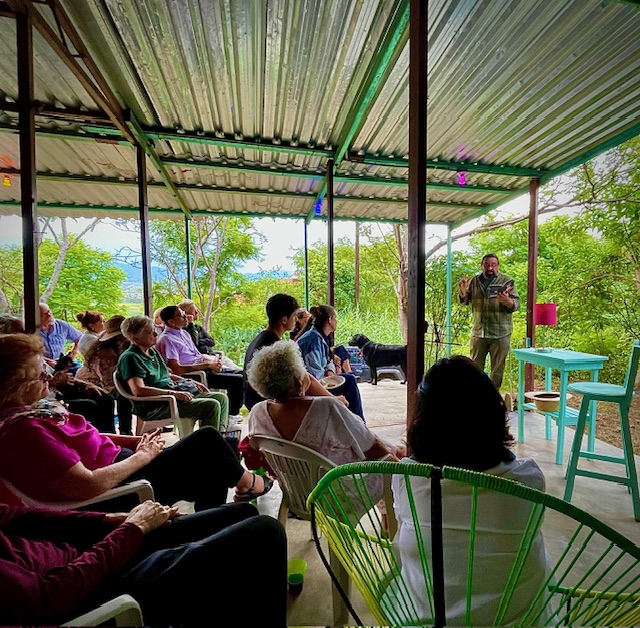
I interviewed international poet and translator Mark Statman about Volverse/Volver, his 14th published collection. Mark, who has won national arts awards, is Emeritus Professor of Literary

I interviewed Lisa Dart, finalist in the Grolier, Aesthetica and Troubadour Poetry Prizes and author of The Linguistics of Light (poems, Salt, 2008), Fathom (prose
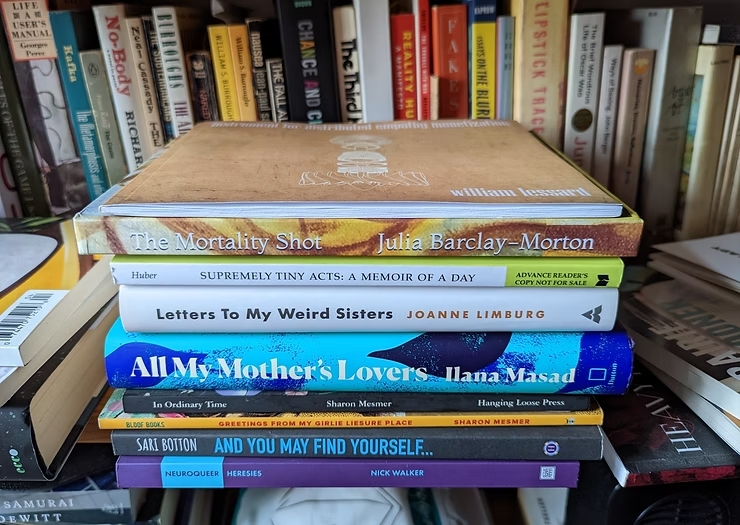
I interviewed writer Julia Lee Barclay-Morton about her experience of autism. Julia began as an experimental dramatist in New York, moving to the UK to

I interviewed Gillean McDougall from Glasgow, who edited the collaborative projects Honest Error (on Charles Rennie Mackintosh and his wife Margaret Macdonald) and Writing the
| Cookie | Duration | Description |
|---|---|---|
| cookielawinfo-checkbox-analytics | 11 months | This cookie is set by GDPR Cookie Consent plugin. The cookie is used to store the user consent for the cookies in the category "Analytics". |
| cookielawinfo-checkbox-functional | 11 months | The cookie is set by GDPR cookie consent to record the user consent for the cookies in the category "Functional". |
| cookielawinfo-checkbox-necessary | 11 months | This cookie is set by GDPR Cookie Consent plugin. The cookies is used to store the user consent for the cookies in the category "Necessary". |
| cookielawinfo-checkbox-others | 11 months | This cookie is set by GDPR Cookie Consent plugin. The cookie is used to store the user consent for the cookies in the category "Other. |
| cookielawinfo-checkbox-performance | 11 months | This cookie is set by GDPR Cookie Consent plugin. The cookie is used to store the user consent for the cookies in the category "Performance". |
| viewed_cookie_policy | 11 months | The cookie is set by the GDPR Cookie Consent plugin and is used to store whether or not user has consented to the use of cookies. It does not store any personal data. |
One Response
Great interview with a very interesting subject. I can completely relate to hearing voices, as I have heard voices myself at very crucial times in my life. Thanks for showing this on your Blog, Leslie.